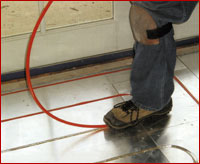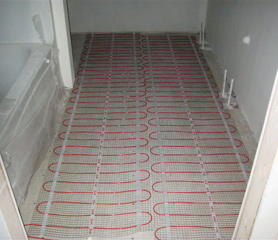Which Radiant Heat System is Best for Me?
What are the Pros and Cons of Radiant Heat and Forced Air Heating Systems?
If you are looking to warm your floors with a radiant heat system and have entered "radiant heat system" into a search engine, you might find yourself scratching your head at this point. There are dozens of products available to purchase, and there are even more companies telling you that their product is the best.
So which product is the best? Should you install a hydronic heating system that pumps hot water through your floors, an electric cable heating system, or a low-voltage screen system? The answer lies in the type of project you are doing. Not every system is ideal for every project, but there is an ideal system for every project.
Hydronic Heating Systems
 Hydronic
radiant floor heating is the most popular type of floor heating, in part because it has been around the
longest. Hydronic
radiant heat systems are comprised of a boiler or hot water heater, pumps, manifolds,
PEX tubing, thermostat, and either gypcrete (a concrete-like material) or wood panels. The flexible
PEX tubing is installed in the pre-cut grooves of the panels.
Hydronic
radiant floor heating is the most popular type of floor heating, in part because it has been around the
longest. Hydronic
radiant heat systems are comprised of a boiler or hot water heater, pumps, manifolds,
PEX tubing, thermostat, and either gypcrete (a concrete-like material) or wood panels. The flexible
PEX tubing is installed in the pre-cut grooves of the panels.
Specially treated water is heated by the boiler and then cycled by the pump through the closed loop of embedded tubing in the floor. Hydronic heating is the most complex of all radiant heat systems. These systems require trained professionals to design, engineer, and perform the installation. Your best economies of scale are achieved for hydronic systems in large areas or entire homes because of their expensive components. Because the boiler of hydronic radiant heat systems can operate on natural gas, the operational costs can be slightly lower than those of equally sized electric radiant heating systems. This makes hydronic systems a popular choice for large radiant heating jobs.
Hydronic systems can be installed under any type of flooring. Most hydronic systems require hot water tubing to be installed in a 2-4-inch bed of light concrete and are best installed during the initial construction because of its weight load demands and adjustments to floor height. Recent low-mass products have been developed to avoid these challenges by fitting the tubing into pre-cut panels (RauPanels™), making hydronic systems more convenient and possible for most major remodeling projects.
If you want to install radiant heat in smaller areas like a bathroom or kitchen, a
hydronic floor heating system may not be the best value for you. The complexity and
cost of installing the system, along with the long-term maintenance and up-keep
required is not worth the small amount you will save in operational costs.
Electric Radiant Heating Systems
Electric radiant heat systems, often called line- or high-voltage systems,
utilize relatively thin heat cable and are quite popular, especially for heating
smaller areas (10-300 square feet) like bathrooms, kitchens, and sun rooms. These
systems include a thermostat and radiant heating cable. On some systems,
the heating cable will
be shipped to you as a large spool of cable. These systems are oftentimes less
expensive, and give you the ability to space the cable how you want. This is
especially handy if you have an odd shaped room that requires a customized
layout to heat every square inch of your floor. Other systems have the cable
pre-spaced and attached to a plastic mesh or tape to create
a mat that can be easily rolled out during installation.
 Whether
you purchase the heat cable on spools or in mats, the systems are equally effective,
so when determining which system to purchase, you should examine the area to be heated
and determine what would be best. Also take into account the ease of installation. A
radiant heat provider will work with you the ensure that you make the best decisions
concerning your floor heating project.
Whether
you purchase the heat cable on spools or in mats, the systems are equally effective,
so when determining which system to purchase, you should examine the area to be heated
and determine what would be best. Also take into account the ease of installation. A
radiant heat provider will work with you the ensure that you make the best decisions
concerning your floor heating project.
Some heat cable must be embedded in a separate layer of concrete or mortar, whereas other systems can simply be installed in the thinset. Many radiant floor heating systems can only be installed under tile. However, on others, if the cable is embedded in mortar or concrete, any flooring can be installed on top of the concrete. When heating smaller areas, it is nearly impossible to beat the simplicity and price of an electric radiant heating system.
Low-Voltage Heating Element
Finally, there are low-voltage radiant heat systems. These systems are ideal for
mid-size to larger areas (300-3000 square feet) and are comprised of a control box,
transformer, heating screen or cable, and
thermostat. FloorHeat is a low-voltage
radiant heating system and that features an extremely low profile heating
element. FloorHeat is a 12-inch wide, thin, durable polymer heating element that is
self-regulating. FloorHeat is practically paper thin and does not buildup floors
during the installation.
It can be installed directly under any type of flooring including hardwood, tile, laminates, and carpet. Whereas most cable systems must be installed on top of the concrete board when installing tile, FloorHeat can be installed underneath it. These systems are easy to install and don't require maintenance like a hydronic system. The self-regulating capability of FloorHeat means that when the ambient temperature rises, the electrical resistance increases and the consumption of electricity decreases. For this reason, the element cannot overheat, and the system is extremely energy efficient.
Radiant heat technology has made significant advances over the years and is an excellent way to supplement your existing heating system or be your sole source of heat. One good way to be assured that you're being sold the best system for your project is to buy from a company that offers all of the available types of radiant heat.
Warmzone is one company who carries various types of radiant systems and is dedicated to specifying the product that makes the most sense for each individual job. Without a bias towards one system, they have become a consumer advocate in the radiant industry and will save you time and money.
Warmzone has already done the research and has selected to only work with the best products on the market. Because they are a large nationwide wholesaler, they can offer you the best pricing by selling to you direct. You can receive a free estimate for your project by submitting a request at www.warmzone.com or calling them at 1-888-488-WARM (9276).
BACK TO
ARTICLES HOME
